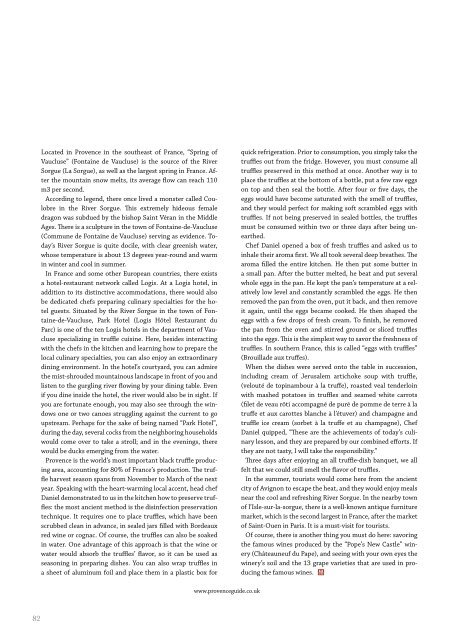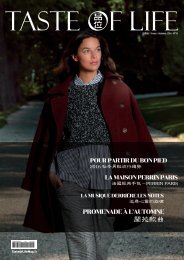You also want an ePaper? Increase the reach of your titles
YUMPU automatically turns print PDFs into web optimized ePapers that Google loves.
Located in Provence in the southeast of <strong>France</strong>, “<strong>Spring</strong> of<br />
Vaucluse” (Fontaine de Vaucluse) is the source of the River<br />
Sorgue (La Sorgue), as well as the largest spring in <strong>France</strong>. After<br />
the mountain snow melts, its average flow can reach 110<br />
m3 per second.<br />
According to legend, there once lived a monster called Coulobre<br />
in the River Sorgue. This extremely hideous female<br />
dragon was subdued by the bishop Saint Véran in the Middle<br />
Ages. There is a sculpture in the town of Fontaine-de-Vaucluse<br />
(Commune de Fontaine de Vaucluse) serving as evidence. Today’s<br />
River Sorgue is quite docile, with clear greenish water,<br />
whose temperature is about 13 degrees year-round and warm<br />
in winter and cool in summer.<br />
In <strong>France</strong> and some other European countries, there exists<br />
a hotel-restaurant network called Logis. At a Logis hotel, in<br />
addition to its distinctive accommodations, there would also<br />
be dedicated chefs preparing culinary specialties for the hotel<br />
guests. Situated by the River Sorgue in the town of Fontaine-de-Vaucluse,<br />
Park Hotel (Logis Hôtel Restaurant du<br />
Parc) is one of the ten Logis hotels in the department of Vaucluse<br />
specializing in truffle cuisine. Here, besides interacting<br />
with the chefs in the kitchen and learning how to prepare the<br />
local culinary specialties, you can also enjoy an extraordinary<br />
dining environment. In the hotel’s courtyard, you can admire<br />
the mist-shrouded mountainous landscape in front of you and<br />
listen to the gurgling river flowing by your dining table. Even<br />
if you dine inside the hotel, the river would also be in sight. If<br />
you are fortunate enough, you may also see through the windows<br />
one or two canoes struggling against the current to go<br />
upstream. Perhaps for the sake of being named “Park Hotel”,<br />
during the day, several cocks from the neighboring households<br />
would come over to take a stroll; and in the evenings, there<br />
would be ducks emerging from the water.<br />
Provence is the world’s most important black truffle producing<br />
area, accounting for 80% of <strong>France</strong>’s production. The truffle<br />
harvest season spans from November to March of the next<br />
year. Speaking with the heart-warming local accent, head chef<br />
Daniel demonstrated to us in the kitchen how to preserve truffles:<br />
the most ancient method is the disinfection preservation<br />
technique. It requires one to place truffles, which have been<br />
scrubbed clean in advance, in sealed jars filled with Bordeaux<br />
red wine or cognac. Of course, the truffles can also be soaked<br />
in water. One advantage of this approach is that the wine or<br />
water would absorb the truffles’ flavor, so it can be used as<br />
seasoning in preparing dishes. You can also wrap truffles in<br />
a sheet of aluminum foil and place them in a plastic box for<br />
www.provenceguide.co.uk<br />
quick refrigeration. Prior to consumption, you simply take the<br />
truffles out from the fridge. However, you must consume all<br />
truffles preserved in this method at once. Another way is to<br />
place the truffles at the bottom of a bottle, put a few raw eggs<br />
on top and then seal the bottle. After four or five days, the<br />
eggs would have become saturated with the smell of truffles,<br />
and they would perfect for making soft scrambled eggs with<br />
truffles. If not being preserved in sealed bottles, the truffles<br />
must be consumed within two or three days after being unearthed.<br />
Chef Daniel opened a box of fresh truffles and asked us to<br />
inhale their aroma first. We all took several deep breathes. The<br />
aroma filled the entire kitchen. He then put some butter in<br />
a small pan. After the butter melted, he beat and put several<br />
whole eggs in the pan. He kept the pan’s temperature at a relatively<br />
low level and constantly scrambled the eggs. He then<br />
removed the pan from the oven, put it back, and then remove<br />
it again, until the eggs became cooked. He then shaped the<br />
eggs with a few drops of fresh cream. To finish, he removed<br />
the pan from the oven and stirred ground or sliced truffles<br />
into the eggs. This is the simplest way to savor the freshness of<br />
truffles. In southern <strong>France</strong>, this is called “eggs with truffles”<br />
(Brouillade aux truffes).<br />
When the dishes were served onto the table in succession,<br />
including cream of Jerusalem artichoke soup with truffle,<br />
(velouté de topinambour à la truffe), roasted veal tenderloin<br />
with mashed potatoes in truffles and seamed white carrots<br />
(filet de veau rôti accompagné de puré de pomme de terre à la<br />
truffe et aux carottes blanche à l’étuver) and champagne and<br />
truffle ice cream (sorbet à la truffe et au champagne), Chef<br />
Daniel quipped, “These are the achievements of today’s culinary<br />
lesson, and they are prepared by our combined efforts. If<br />
they are not tasty, I will take the responsibility.”<br />
Three days after enjoying an all truffle-dish banquet, we all<br />
felt that we could still smell the flavor of truffles.<br />
In the summer, tourists would come here from the ancient<br />
city of Avignon to escape the heat, and they would enjoy meals<br />
near the cool and refreshing River Sorgue. In the nearby town<br />
of l’Isle-sur-la-sorgue, there is a well-known antique furniture<br />
market, which is the second largest in <strong>France</strong>, after the market<br />
of Saint-Ouen in Paris. It is a must-visit for tourists.<br />
Of course, there is another thing you must do here: savoring<br />
the famous wines produced by the “Pope’s New Castle” winery<br />
(Châteauneuf du Pape), and seeing with your own eyes the<br />
winery’s soil and the 13 grape varieties that are used in producing<br />
the famous wines.<br />
© Lionel Moulet<br />
Logis Hôtel Restaurant du Parc<br />
82 83













